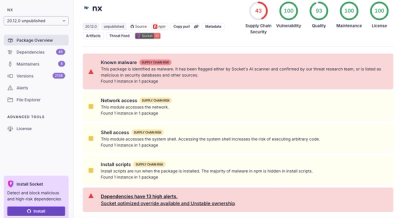
Security News
Nx npm Packages Compromised in Supply Chain Attack Weaponizing AI CLI Tools
Malicious Nx npm versions stole secrets and wallet info using AI CLI tools; Socket’s AI scanner detected the supply chain attack and flagged the malware.
@fugle/realtime-nest
Advanced tools
A Nest module wrapper for @fugle/realtime
To begin using it, we first install the required dependencies.
$ npm install --save @fugle/realtime-nest @fugle/realtime
Once the installation is complete, to use the HttpClient or WebSocketClient, first import FugleRealtimeModule and pass the options with apiToken to the register() method.
import { Module } from '@nestjs/common';
import { FugleRealtimeModule } from '@fugle/realtime-nest';
@Module({
imports: [
FugleRealtimeModule.register({
apiToken: 'demo',
}),
],
})
export class IntradayModule {}
Next, inject the HttpClient instance using the @InjectHttpClient() decorator.
constructor(@InjectHttpClient() private readonly client: HttpClient) {}
The @InjectWebSocketClient() decorator is used for the WebSocketClient instance injection.
constructor(@InjectWebSocketClient() private readonly client: WebSocketClient) {}
When you need to pass module options asynchronously instead of statically, use the registerAsync() method. As with most dynamic modules, Nest provides several techniques to deal with async configuration.
One technique is to use a factory function:
FugleRealtimeModule.registerAsync({
useFactory: () => ({
apiToken: 'demo',
}),
});
Like other factory providers, our factory function can be async and can inject dependencies through inject.
FugleRealtimeModule.registerAsync({
imports: [ConfigModule],
useFactory: async (configService: ConfigService) => ({
apiToken: configService.get('FUGLE_REALTIME_API_TOKEN'),
}),
inject: [ConfigService],
});
Alternatively, you can configure the FugleRealtimeModule using a class instead of a factory, as shown below.
FugleRealtimeModule.registerAsync({
useClass: FugleRealtimeConfigService,
});
The construction above instantiates FugleRealtimeConfigService inside FugleRealtimeModule, using it to create an options object. Note that in this example, the FugleRealtimeConfigService has to implement FugleRealtimeModuleOptionsFactory interface as shown below. The FugleRealtimeModule will call the createFugleRealtimeOptions() method on the instantiated object of the supplied class.
@Injectable()
class FugleRealtimeConfigService implements FugleRealtimeModuleOptionsFactory {
createFugleRealtimeOptions(): FugleRealtimeModuleOptions {
return {
apiToken: 'demo',
};
}
}
If you want to reuse an existing options provider instead of creating a private copy inside the FugleRealtimeModule, use the useExisting syntax.
FugleRealtimeModule.registerAsync({
imports: [ConfigModule],
useExisting: FugleRealtimeConfigService,
});
FAQs
A Nest module wrapper for @fugle/realtime
The npm package @fugle/realtime-nest receives a total of 3 weekly downloads. As such, @fugle/realtime-nest popularity was classified as not popular.
We found that @fugle/realtime-nest demonstrated a not healthy version release cadence and project activity because the last version was released a year ago. It has 4 open source maintainers collaborating on the project.
Did you know?

Socket for GitHub automatically highlights issues in each pull request and monitors the health of all your open source dependencies. Discover the contents of your packages and block harmful activity before you install or update your dependencies.

Security News
Malicious Nx npm versions stole secrets and wallet info using AI CLI tools; Socket’s AI scanner detected the supply chain attack and flagged the malware.

Security News
CISA’s 2025 draft SBOM guidance adds new fields like hashes, licenses, and tool metadata to make software inventories more actionable.

Security News
A clarification on our recent research investigating 60 malicious Ruby gems.